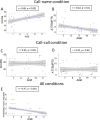Changes in audio-spatial working memory abilities during childhood: The role of spatial and phonological development
- PMID: 34905544
- PMCID: PMC8670674
- DOI: 10.1371/journal.pone.0260700
Changes in audio-spatial working memory abilities during childhood: The role of spatial and phonological development
Abstract
Working memory is a cognitive system devoted to storage and retrieval processing of information. Numerous studies on the development of working memory have investigated the processing of visuo-spatial and verbal non-spatialized information; however, little is known regarding the refinement of acoustic spatial and memory abilities across development. Here, we hypothesize that audio-spatial memory skills improve over development, due to strengthening spatial and cognitive skills such as semantic elaboration. We asked children aged 6 to 11 years old (n = 55) to pair spatialized animal calls with the corresponding animal spoken name. Spatialized sounds were emitted from an audio-haptic device, haptically explored by children with the dominant hand's index finger. Children younger than 8 anchored their exploration strategy on previously discovered sounds instead of holding this information in working memory and performed worse than older peers when asked to pair the spoken word with the corresponding animal call. In line with our hypothesis, these findings demonstrate that age-related improvements in spatial exploration and verbal coding memorization strategies affect how children learn and memorize items belonging to a complex acoustic spatial layout. Similar to vision, audio-spatial memory abilities strongly depend on cognitive development in early years of life.
Conflict of interest statement
The authors have declared that no competing interests exist.
Figures







Similar articles
-
Spatial Memory and Blindness: The Role of Visual Loss on the Exploration and Memorization of Spatialized Sounds.Front Psychol. 2022 May 24;13:784188. doi: 10.3389/fpsyg.2022.784188. eCollection 2022. Front Psychol. 2022. PMID: 35686077 Free PMC article.
-
Environment learning using descriptions or navigation: The involvement of working memory in young and older adults.Br J Psychol. 2016 May;107(2):259-80. doi: 10.1111/bjop.12145. Epub 2015 Aug 17. Br J Psychol. 2016. PMID: 26280566
-
Cognitive abilities in children with specific language impairment: consideration of visuo-spatial skills.Int J Lang Commun Disord. 2005 Apr-Jun;40(2):137-49. doi: 10.1080/13682820400011507. Int J Lang Commun Disord. 2005. PMID: 16101271
-
The impact of spatial and verbal working memory load on semantic relatedness judgements.Psychon Bull Rev. 2024 Apr;31(2):781-789. doi: 10.3758/s13423-023-02323-0. Epub 2023 Sep 18. Psychon Bull Rev. 2024. PMID: 37723334 Free PMC article.
-
Limitations in working memory: implications for language development.Int J Lang Commun Disord. 2000 Jan-Mar;35(1):95-116. doi: 10.1080/136828200247278. Int J Lang Commun Disord. 2000. PMID: 10824227
Cited by
-
Spatial Memory and Blindness: The Role of Visual Loss on the Exploration and Memorization of Spatialized Sounds.Front Psychol. 2022 May 24;13:784188. doi: 10.3389/fpsyg.2022.784188. eCollection 2022. Front Psychol. 2022. PMID: 35686077 Free PMC article.
-
Learning to play a musical instrument in the middle school is associated with superior audiovisual working memory and fluid intelligence: A cross-sectional behavioral study.Front Psychol. 2022 Oct 13;13:982704. doi: 10.3389/fpsyg.2022.982704. eCollection 2022. Front Psychol. 2022. PMID: 36312139 Free PMC article.
References
-
- Miyake A, Shah P. Toward Unified Theories of Working Memory: Emerging General Consensus, Unresolved Theoretical Issues, and Future Research Directions. Models of Working Memory. 2012. doi: 10.1017/cbo9781139174909.016 - DOI
-
- Baddeley A, Hitch G. Working Memory. Recent advances in learning and motivation. 1974. pp. 47–90.
Publication types
MeSH terms
LinkOut - more resources
Full Text Sources
Miscellaneous

